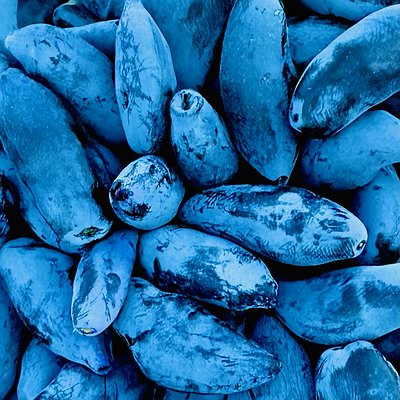Local farmer sows powerhouse honeyberries
When David Dunn bought his property on Farm to Market Road in 2012, with his dog, Shayla, the land was raw and he hosted his neighbor’s cows.
Now, his 15-acre farm, Big Sky Honeyberries, boasts an orderly arrangement of healthy honeyberry bushes that were planted by hand.
“It's been a six-year process. I got everything in the ground three years ago,” Dunn said. “We formed the rows, laid the weed mat, then punched holes and individually planted 10,000 of them.”
Before that, he spent time digging water lines and getting the ground ready with customized soil. He said the plants took off once they were out of the starter pots. Then, Dunn, who doesn’t use any sprays on the plants, hand weeded the entire orchard, all 8 miles, with help from a church friend.
“Definitely, a lot of grace went into this and help from others,” Dunn said. “I didn't do this on my own.”
Honeyberries are also known as haskaps, a name that honors the people of northern Japan, where the first varieties used in North America originated. They are also called blue honeysuckle.
“This is actually the healthiest berry, arguably, on the planet, and I can grow it on Farm to Market Road in average to subpar average soil and it fruits in my alkaline soil,” Dunn said. “It's pretty special in its cold hardiness.”
“It can take 40 below,” he added. “Flowers can take a frost in the spring and still berry.”
Currently, Dunn and just one other farmer in the Bitterroot Valley are producing honeyberries commercially in Montana.
“The dream is to consult and plant these everywhere in Montana,” he said. “I've got most of the things I need to form rows for other people. It'd be pretty fulfilling to see other people growing them.”
According to the Montana State University Extension, honeyberries were first bred in North America in the early 2000s at Oregon State University and the University of Saskatchewan.
The berry is noted for its nutritional value.
“I can grow the healthiest berry on the planet in Northwest Montana, better than acai,” Dunn said. “It's more of a special cultivar that nobody's done this big yet, because it costs so much money and it’s not really proven.
“The data is there on the berry,” he said. “It is a superfood.”
This August, MSU researchers received a grant to study the potential health benefits of honeyberries.
“Haskap berries have anti-inflammatory properties and are rich in polyphenols, which are found in many plant foods and act as antioxidants,” said Zach Miller, superintendent of MSU’s Western Agricultural Research Center. "Haskaps may also have other untapped health benefits.”
The berries are high in phenolics, very high in vitamin C and have a low glycemic load. They are full of vitamins, macroelements and microelements.
“It’s rich in anthocyanin which basically triggers your body’s detox function,” Dunn said. “It's got a lot of skin. Two flowers become one berry and a lot of the nutrition is in the skin of a berry.”
The fruit is as oddly shaped as it is extraordinary. The berries are an elongated sphere, like a mostly deflated mini beach ball. They are nearly an inch long and boast a beautiful, dark purple color. The flesh is a deep red/blue, making for spectacularly colored smoothies.
The taste has been described as a cross between a raspberry and a blueberry. It can be enjoyed by the handful or in baked goods, jams, juice and wines.
“They're the first thing to wake up and they flower right when the plant wakes up,” Dunn said. “It’s ripe usually mid to late June, done the first week of August.”
During the eight-week window when fresh honeyberries are available, Dunn invites people to the farm to pick berries. He also sells Big Sky Honeyberries at the Kalispell and Whitefish farmers markets.
Frozen honeyberries are available now at The Farmers Stand in Whitefish, Mountain Valley Foods in Kalispell and the the Neighborhood Market in Evergreen.
For more information, see David Dunn’s Instagram @bigskyhoneyberries.







